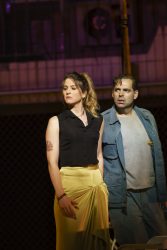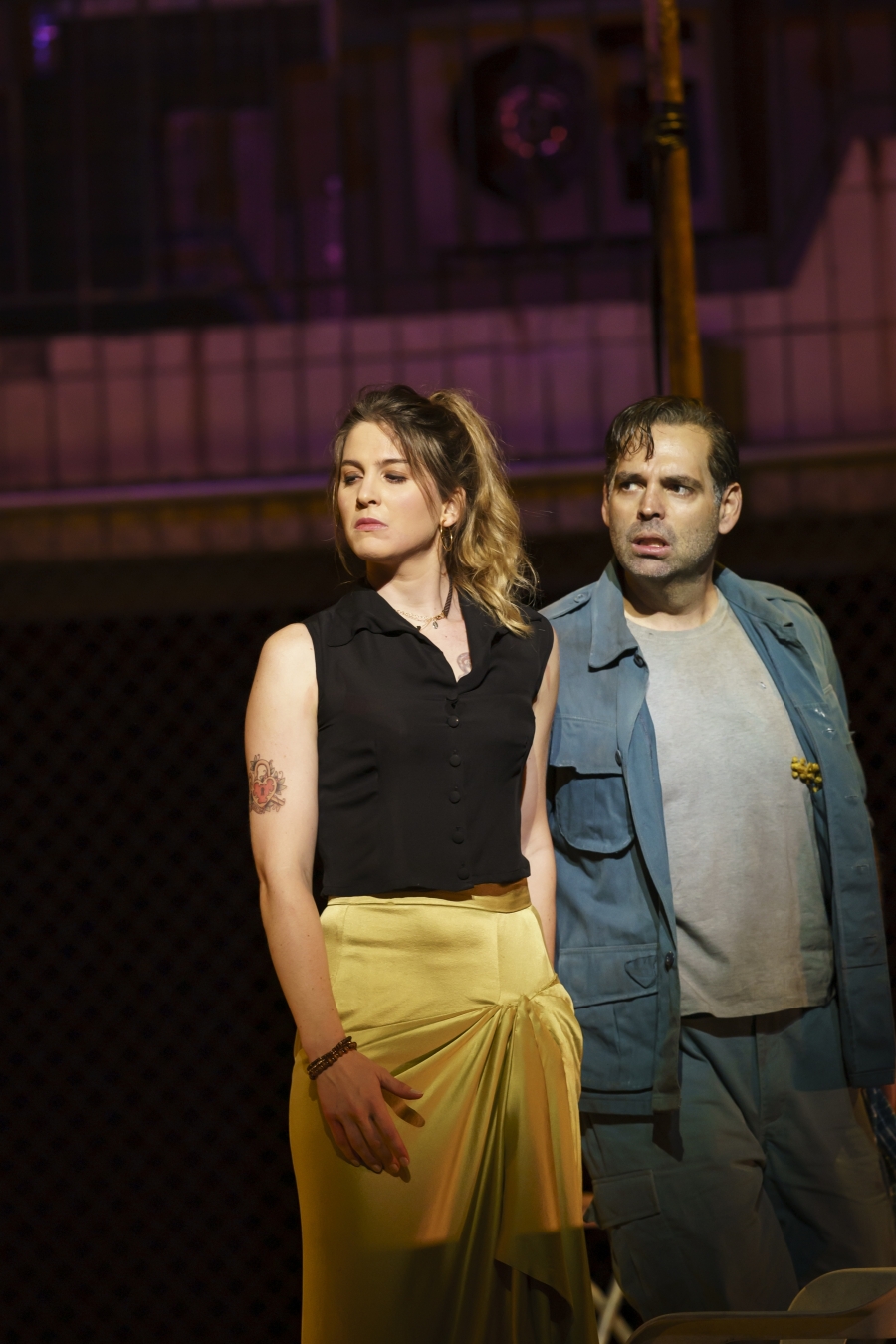 United Kingdom Bizet, Carmen: Soloists, Orchestra and Chorus of Welsh National Opera / Tomáš Hanus (conductor). Wales Millennium Centre, Cardiff, 21.9.2019. (GPu)
United Kingdom Bizet, Carmen: Soloists, Orchestra and Chorus of Welsh National Opera / Tomáš Hanus (conductor). Wales Millennium Centre, Cardiff, 21.9.2019. (GPu)

(c) Bill Cooper
Production:
Director – Jo Davies
Set designer – Leslie Travers
Costume designer – Gabrielle Dalton
Lighting designer – Oliver Fenwick
Cast:
Carmen – Virginie Verrez
Don José – Dimitri Pattas
Escamillo – Philip Rhodes
Micaëla – Anita Watson
Zuniga – Henry Waddington
Frasquita – Harriet Eyley
Mercédès – Angela Simkin
Moralès – Ross Ramgobin
Dancaïre – Benjamin Bevan
Remendado – Joe Roche
Lillas Pastia/Guide – Gregory A. Smith
Dancers – Josie Sinnadurai, Carmine De Amicis
Jo Davies’s interesting new production of Carmen relocates the action from Seville to a Latin American setting. The director’s essay in the programme (significantly sub-titled ‘Carmen: a question of class?’) tells us, plausibly enough, that ‘The world of the Brazilian favelas and the tight community life within, often historically pitted against the army, seemed to fit both the economic and sexual politics of Carmen and seemed a good home for her wild bohemian spirit’. Though I have some doubts about the appositeness of the closing description of Carmen herself, the earlier parts of Davies’s statement seem pretty fair. In many productions of Carmen, the military presence in the opening scene can seem rather odd – followed as it often is by a rather romanticised account of life in Andalusia. But here the machine-gun-toting soldiers remain to ‘observe’ most of the later scenes too – the life of Carmen and her social peers being conducted under the shadow of relentlessly restrictive military force. This gives a particular force to some of the libretto’s later pronouncements about liberty and freedom – though not so as to persuade one that either Carmen or the smugglers are any kind of political activists (all the smugglers want to liberate is other people’s property). That most of the characters in the opera live a life of utter poverty is also underlined by many details of the production. We are, in effect, invited to see the ‘arc’ of Carmen’s life and death as ‘representing’ a kind of fight for political freedom. While that may be a partial truth about Carmen, it isn’t, I think, either the ‘whole’ truth or even an especially important truth about the work. It makes us less likely (and this may be a good thing?) to think about Don José’s choice as one between the domesticity that Micaëla represents and, on the other hand, the sensuality, the apparent passion and the actual danger of Carmen, counterpointed by her choice between Don José and Escamillo. Certainly, it is good to have Carmen grounded in some sort of economic reality – not presented as a fantasy of Spanish passion under the sun (not that there is much sunlight in this production).
To turn to the performers, rather than the production – I was very favourably impressed, especially vocally, by the Carmen of Virginie Verrez. She has a fine voice, attractive across its entire range and a vibrant stage presence, yet although a lithe and attractive figure, there wasn’t much of the gipsy about her. Still, I enjoyed listening to her sufficiently to make her name one I shall remember and look out for in future. As Don José, Dimitri Pattas was a somewhat stolid presence. I was never convinced that this soldier had very much of an inner life however much he told us about his emotions. Vocally, he was limited by his narrow range of tone and colour, which also limited the extent to which he could create a plausible and interesting character. As Escamillo, Philip Rhodes had all the necessary swagger and self-assured machismo and gave an enjoyable account of his aria (the so-called ‘Toreador Song’ in Acts II and IV); elsewhere he sang perfectly competently, without a great deal of individuality. Anita Watson’s Micaëla was, for me, more striking. Seen in contrast to Carmen and the other girls of the city (whether Seville or Rio de Janeiro), Micaëla can sometimes seem merely prim and rather characterless. But this Micaëla was attractively delineated as a brave young woman who soon gained one’s respect. Watson’s reading of the aria ‘Je dis que rien ne m’épouvante’ in Act III was aurally beautiful and fully weighted with meaning.
The supporting roles were uniformly well sung and, largely, well-acted. Harriet Eyley (Frasquita) and Angela Simkin (Mercédès) made attractive and vivacious companions of Carmen, singing and acting with pleasing commitment and judgement. The principal smugglers (Dancaïre and Remendado) were well embodied, in voice and action, by (respectively) Benjamin Bevan and Joe Roche, while Henry Waddington carried obvious authority as Zuniga. The chorus maintained the high standards that it has long ago established. The children’s chorus let no one down; they were delightful whether mocking the changing of the guard with their toy guns or – though here the word delightful seems inappropriate – when equipped with ‘real’ guns as what we must, I suppose, call ‘child-soldiers’. There was much to enjoy in the work of the two dancers, Josie Sinnadurai and Carmine De Amicis, especially in their dance at Lillas Pastia’s bar, part flamenco and part tango (yes, I know that is an Argentinian rather than a Brazilian dance, but this production is fluid as to setting).
The orchestra was on good form (one noticed, in particular, some attractive contributions by the flutes), though I have to say that WNO’s music director, the rightly much admired Tomáš Hanus didn’t sound entirely at home in Bizet’s quasi-Spanish idioms, the rhythms often sounding less than fully natural and a little over-studied.
The set by Lesley Travers was a semi-circle of three tiers of galleries facing the audience, generally worked quite well (though to see the set as the mountains of Act III required an audience willing and able to exercise a considerable ‘suspension of disbelief’). The individual ‘rooms’ served as hints of brothels and much else, but what mattered most, it seemed to me, was that as, in effect, one half of an amphitheatre it hinted at one of the libretto’s repeated implied analogies, pointing up the similarity between the bullfight which takes place within the bull ring and the not-unrelated fight for life which takes place outside it (in its own amphitheatre, as it were).
Talking to friends afterwards, I seem to have found the production more interesting and rewarding than many of them had. The stress on Carmen’s economic ‘motives’, the need for her to find a way out of the poverty to which society seems to have condemned her (and what does she have to fight that battle, save her body and sexual allure?) makes more sense of her behaviour and character than most previous productions of Carmen I have seen. But the transposition of location was not without its inconsistencies, often small, but still irritating. I have never been to Rio de Janeiro, but I find it hard to believe that in that Brazilian city (where, after all, Portuguese influence is much stronger than Spanish) so many women wear the distinctively Spanish mantilla as was the case in the crowd attending the bullfight in Act IV of this production. It was almost as though, at the very last moment, Jo Davies and costume designer Gabrielle Dalton had forgotten that the setting had been moved away from Seville.
Glyn Pursglove
For more about WNO click here.
